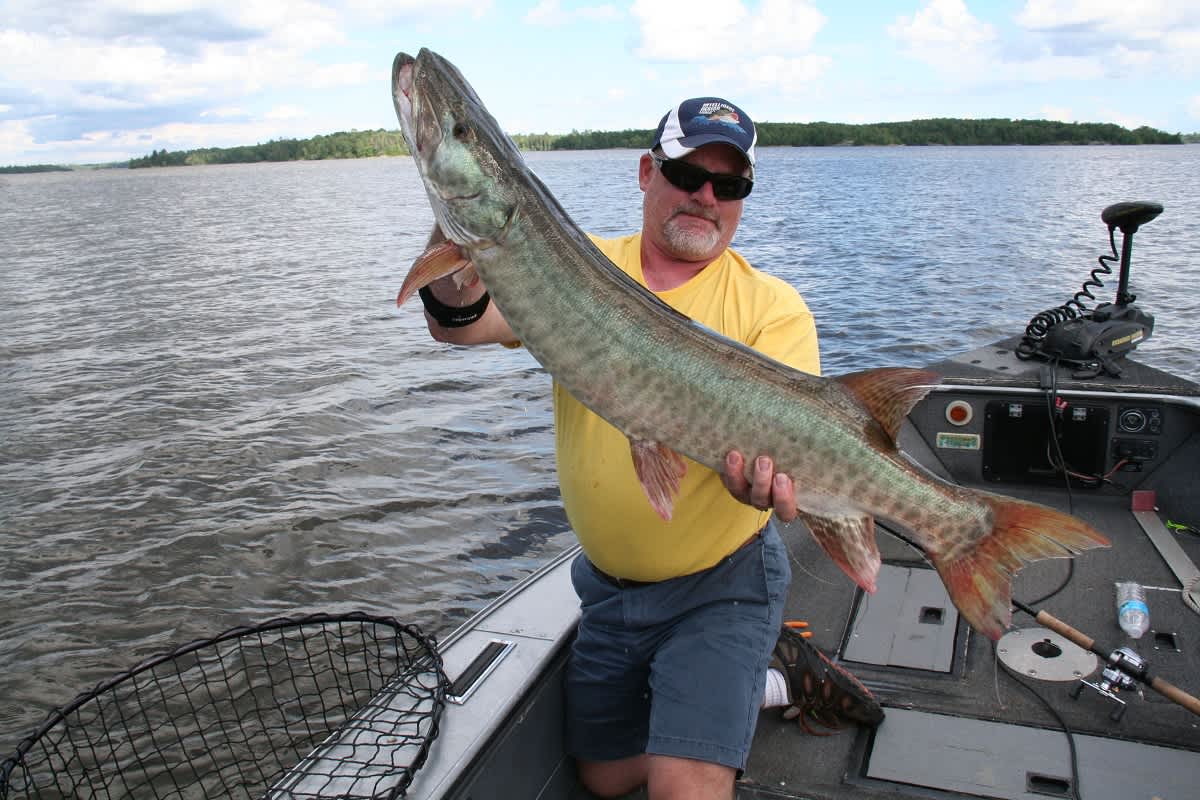Summertime Muskie Fishing Strategies
Bernie Barringer 07.02.14

The water’s warmed up and the big predators are on the prowl. The best place to find summer muskies on most natural lakes is in the weeds. Here are a few tips to help you boat a big muskie this summer.
In the southern half of the United States, anything that grows below the surface of the water is called “grass” by fishermen. In the northern half of the United States and in Canada, anglers call such things “weeds.” Scientists call it “submergent vegetation.” But no matter what you call the plants growing under the water, there is one category of plant that is a huge key to finding fish in the summer. Weeds with wide leaves, called pondweed, that grow in deep water towards the surface attract the most fish. There are a dozen different varieties of the pondweed species, but most muskie anglers lump them into one category called “cabbage.”
Fresh, green cabbage is the lifeblood of summertime fishing because the entire food chain is attracted to it. It’s producing oxygen which attracts microorganisms. These in turn attract bait fish, which are food to larger fish, including the muskies. Cabbage can be found in thick beds with distinct edges or it can be found in loosely defined areas with scattered plants. Both will hold fish. Cabbage may grow as deep as 10 to 12 feet in clear water, or may be found in five feet or less in colored water with poor light penetration. No matter where you find it, cabbage is key to summer muskies, find it and you find the fish.

Once you know where the muskies are likely to be, the second step it to figure out how to get them out of the forest of weeds. There are three ways to fish these cabbage beds: over, through, and around.
Over the cabbage
During the warm summer months when muskies are at their most aggressive, fishing a fast-moving bait over the top of the cabbage can be very productive. Cabbage often doesn’t grow all the way to the surface, and this provides an excellent opportunity. Fish will be lying in the junk, but a big muskie will often rocket up towards the surface when something comes by that triggers a feeding instinct. Topwaters and small, fast-moving bucktails with a lot of lift are good choices for this type of fishing.
The bucktails are search lures, used for finding active fish because you are fishing them fast and covering a lot of water. Those with two wide blades offer the most lift and can be fished just below the surface or even bulging the surface of the water. The noisy topwaters allow you to slow down and target fish that are in a more neutral feeding mode, but can’t resist something that looks easy. One that glugs, churns, glides, or spins along the surface is hard to resist on a calm evening when the fish are most active. Explosive topwater strikes will make an addict out of you.
Through the cabbage
Muskies will rarely be found in the thickest of the sloppy junk. They are big-bodied and they simply cannot maneuver well through thick weeds. But they will often back into a patch of weeds and lie in wait for anything that might come by. Muskies are primarily ambush predators and some vertical baits take advantage of this tendency well. Big plastics like the Medusa, Suzy Sucker, tube jig, and Bulldawg are perfect for fishing in this way. Throw the bait into pockets and holes in the weedbed. Jig them along the bottom and swim them through the openings, anywhere you can get them to work without snagging up. Fish slowly and cover every piece of cover that might be suitable to hold a big fish.
Fishing through the cabbage is as close as you’ll get to finesse fishing when you’re angling for muskie, if there is such a thing. Be patient and work the area meticulously. Sometimes muskies are lying comfortably in wait and won’t take anything that’s not right in front of them.

Around the cabbage
Some areas of cabbage become too thick to fish over or through, particularly late in the summer when they have had a growing season to fill out. Muskies won’t typically be back in the thick stuff, but will set up on the outside edges of the cabbage beds to ambush anything cruising along the weed edges. You’ll find more fish on the deep edge during summer, but don’t overlook the inside edge between the cabbage and the shoreline.
Thick beds often have distinct lines where the weeds end, particularly in the deep water on breaklines where the depth becomes unsuitable for weed growth. These are perfect areas to cast or troll a crankbait along the length of the weedline. A deep-diving bait allows you to get your offering down to the bottom where the fish are most likely to be. Work along the edges casting the bait parallel to the weedline, or troll the bait along the edge. If you feel the bait hit a weed, give it a good hard snap and you can usually tear it loose.
Keep the three things in mind as you search for muskies this summer. First find the fresh green cabbage weed and then look for opportunities to fish over, through and around it. You may be rewarded with a CPR (catch, photo, and release) of a true trophy this year.
Follow Bernie’s bowhunting adventures on his blog, bowhuntingroad.com.

